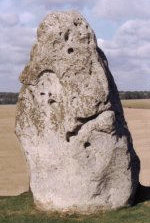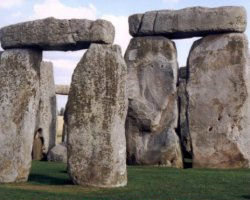
A complex 18.6 year cycle of the Moon may have also played a major role in the design.
Large "Station Stones" are aligned in the direction of the northernmost moonset and
the southernmost moonrise.
According the English Heritage Organization, the first stage of construction
was just a circle of heavy timbers surrounded by a ditch and an earthen bank.
Creating the ditch provided the material for the bank. The ditch would have been dug by hand using
animal bones. Deer antlers were used as pick-axes to loosen the underlying chalk and then the
shoulder blades of oxen or cattle were used as shovels to clear away boulders. Excavations of the
ditch have recovered antlers that were left behind deliberately and it was by radio carbon dating
that researchers concluded that the first henge was built over 5,000 years ago.
"That's where the mystery begins. We haven't just found old bones,
around the edge of the bank we also found 56 holes now known as Aubrey Holes, named after
the 17th century antiquarian, John Aubrey, who found them in about 1666. We know that these
holes were dug to hold wooden posts, just as holes were dug later to hold the stone pillars
that you see today. So this was the first stage built about 5,050 years ago, a wooden post circle
surrounded by a deep ditch and bank."~ english-heritage.org
Then around 2,500 BC (2,400 years before the Romans advanced into
Britain), it was rebuilt using stones. Bluestones were used first, which are the smaller
stones of the monument. Geologist have determined that these came from the Prescelli Mountains in Pembroke,
South Wales, 380kms (245 miles) away, perhaps dragged on rollers and sledges to the headwaters on
Milford Haven, and then loaded onto rafts. Placed on a raft, a large mass is relatively easy to transport.
The rafts could have travelled by water along the south coast of Wales
and up the rivers Avon and Frome, before being dragged overland again to near Warminster in
Wiltshire. The final stage of the journey was mainly by water, down the river Wylye to Salisbury,
then the Salisbury Avon to west Amesbury. The journey covers nearly 240 miles.
It was an amazing feat when you consider
that each stone weighs about five tons. It required unbelievable dedication by these people
with their ancient technology to
bring the stones all the way from South Wales. Such huge expenditures of man-hours in the ancient world
are thought to be usually associated with spiritual motivations.

Before the second phase of Stonehenge was complete, work stopped and there was a period of
abandonment. Then some later generations renovated, building a bigger and more complicated
monument. That construction phase lasted until about 4,300 years ago.
The remnant of that effort is the Stonehenge we know today.
The bluestones were dug up and rearranged and this time even bigger stones were brought in
from the Marlborough Downs, 25 miles away. These giant sandstones, or sarsenstones as they
are now called, were hammered to size and shaped using balls of stone known as mauls. Even today you can
see the drag marks. Each pair of stones was heaved upright and linked on the top by the lintels.
To get the lintels to stay in place, they made joints
in the stones, linking the lintels in a circular manner using a tongue and groove joint, and subsequently
the upright and lintel with a ball and socket joint, or mortise and tendon. This was all cleverly
designed on the alignment of the rising of the summer solstice sun and the setting of the winter
solstice sun.

How did these ancient tribes move the huge sarsenstones, some weighing more than 50 tons?
How did they get them to stand upright? Nobody really knows for sure. It obviously required
the sheer muscle power of hundreds of people with ropes to relocate each of these megaliths.
Modern calculations show that it would have taken 500 people using leather ropes to pull one stone,
and another 100 people to move and lay the huge log rollers in front of the sledge. Others must have provided support services, such as organization and planning, and food and water.
These larger stones were arranged in an outer circle with a continuous run of lintels on top. Inside the circle,
the five huge famous trilithons were placed in a horseshoe arrangement. The open end
of the horseshoe faces towards the Heelstone
and the 1.8 mile long avenue that they built that leads to the river Avon.
Recent excavations have revealed that a large region of the Salisbury Plains surrounding the Stonehenge monument was the site of major cultural activity in ancient times which
included other major monuments.
It now seems likely that the area was an extensive complex of inter-tribal communications including commerce, festivities, religion, and politics.